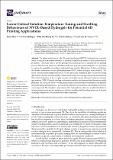| dc.contributor.author | Zhuo, Shuo | |
| dc.contributor.author | Halligan, Elaine | |
| dc.contributor.author | Tie, Billy Shu Hieng | |
| dc.contributor.author | Breheny, Colette | |
| dc.contributor.author | Geever, Luke M. | |
| dc.date.accessioned | 2022-09-13T10:11:53Z | |
| dc.date.available | 2022-09-13T10:11:53Z | |
| dc.date.copyright | 2022 | |
| dc.date.issued | 2022-08-02 | |
| dc.identifier.citation | Zhuo, S.; Halligan, E.; Tie, B.S.H.; Breheny, C.; Geever, L.M. (2022). Lower critical solution temperature tuning and swelling behaviours of NVCL-based hydrogels for potential 4DF printing applications. Polymers, 14, 3155. https://doi.org/ 10.3390/polym14153155 | en_US |
| dc.identifier.uri | http://research.thea.ie/handle/20.500.12065/4039 | |
| dc.description.abstract | The phase transitions of poly (N-vinyl caprolactam) (PNVCL) hydrogels are currently
under investigation as possible materials for biomedical applications thanks to their thermosensitive
properties. This study aims to use the photopolymerisation process to simulate the 4D printing
process. NVCL-based polymers with different thermal properties and swellability were prepared
to explore the possibility of synthetic hydrogels being used for 4D printing. In this contribution,
the thermal behaviours of novel photopolymerised NVCL-based hydrogels were analysed. The
lower critical solution temperature (LCST) of the physically crosslinked gels was detected using
differential scanning calorimetry (DSC), ultraviolet (UV) spectroscopy, and cloud point measurement.
The chemical structure of the xerogels was characterised by means of Fourier transform infrared
spectroscopy (FTIR). Pulsatile swelling studies indicated that the hydrogels had thermo-reversible
properties. As a result, the effect of varying the macromolecular monomer concentration was apparent.
The phase transition temperature is increased when different concentrations of hydrophilic monomers
are incorporated. The transition temperature of the hydrogels may allow for excellent flexibility in
tailoring transition for specific applications, while the swelling and deswelling behaviour of the gels
is strongly temperature- and monomer feed ratio-dependent. | en_US |
| dc.format | PDF | en_US |
| dc.language.iso | eng | en_US |
| dc.publisher | MDPI | en_US |
| dc.relation.ispartof | Polymers | en_US |
| dc.rights | Attribution-NonCommercial-NoDerivatives 4.0 International | * |
| dc.rights.uri | http://creativecommons.org/licenses/by-nc-nd/4.0/ | * |
| dc.subject | NVCL | en_US |
| dc.subject | Photopolymerisation | en_US |
| dc.subject | LCST tuning | en_US |
| dc.subject | Pulsatile swelling studies | en_US |
| dc.title | Lower critical solution temperature tuning and swelling behaviours of NVCL-based hydrogels for potential 4DF printing applications. | en_US |
| dc.type | info:eu-repo/semantics/article | en_US |
| dc.contributor.affiliation | Technological University of the Shannon Midlands Midwest | en_US |
| dc.contributor.sponsor | Technological University of the Shannon: Midlands Midwest, Presidents Seed Fund (PSF). | en_US |
| dc.description.peerreview | yes | en_US |
| dc.identifier.doi | 10.3390/polym14153155 | en_US |
| dc.identifier.eissn | 2073-4360 | |
| dc.identifier.orcid | https://orcid.org/0000-0003-1728-1374 | en_US |
| dc.identifier.orcid | https://orcid.org/0000-0002-5462-5888 | en_US |
| dc.identifier.orcid | https://orcid.org/0000-0001-6923-4807 | en_US |
| dc.identifier.orcid | https://orcid.org/0000-0002-6967-1086 | en_US |
| dc.identifier.orcid | https://orcid.org/0000-0001-5481-3080 | en_US |
| dc.rights.accessrights | info:eu-repo/semantics/openAccess | en_US |
| dc.subject.department | Materials Research Institute TUS:MM | en_US |
| dc.type.version | info:eu-repo/semantics/publishedVersion | en_US |


